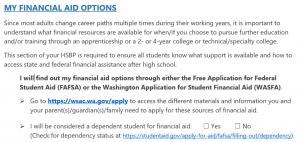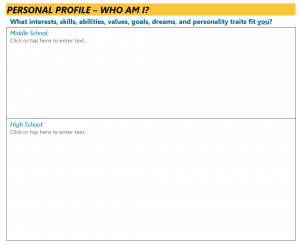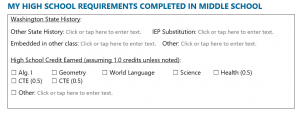At the start of an unusual and challenging school year, many students, families, and educators are juggling a new way of engaging in education. With distance learning in effect across much of Washington, the future may seem a little less clear for many students. However, the High School and Beyond Planning process can offer some clarity and space for aspiration.
In Washington, the majority of job openings will be filled by workers who earn a credential after high school, such as a degree, apprenticeship or certificate. The High School and Beyond Plan (HSBP) is a critical exploration and planning process in supporting students to prepare for and embark on a post-high school plan that fits their interests and sets them up for success in their communities and our state’s economy.
There are some new and exciting changes that have come to the HSBP process for the 2020-2021 school year. Find the updated template here, on the website of the Office of Superintendent of Public Instruction (OSPI), and follow along with what’s new:
 Financial aid options. Financial aid is available for many students to help pay for the costs of education or training after high school. The most commonly used financial aid applications include the Free Application for Federal Student Aid (FAFSA) and the Washington Application for State Financial Aid (WASFA), which is available to students who cannot file, or do not wish to file, a FAFSA. If students are unsure about which application to should complete, they can talk with a school counselor or watch this video from the Washington Student Achievement Council.
Financial aid options. Financial aid is available for many students to help pay for the costs of education or training after high school. The most commonly used financial aid applications include the Free Application for Federal Student Aid (FAFSA) and the Washington Application for State Financial Aid (WASFA), which is available to students who cannot file, or do not wish to file, a FAFSA. If students are unsure about which application to should complete, they can talk with a school counselor or watch this video from the Washington Student Achievement Council.
On pages 11 and 14 of the updated HSBP template, students can find resources to learn more about financial aid and the application process, make a list of colleges they’re interested in and relevant deadlines, and set up a plan for pursuing financial aid. As of this year, learning about financial aid is a required part of the HSBP process and is meant to better support students as they prepare for life after high school. Even if college isn’t a student’s goal for right after high school, knowing how to access financial assistance can make it easier to pursue further education and training later as career interests change.
 Alignment of the HSBP with IEP Transition Plans. For students with disabilities who have an Individualized Education Program (IEP) Transition Plan, they should receive the same career and college readiness services and supports as their peers in general education. OSPI staff have developed resources, templates and checklists, including suggestions to minimize duplication. These supports can help high school counselors or advisors and special services staff collaboratively build HSBPs for all students with disabilities.
Alignment of the HSBP with IEP Transition Plans. For students with disabilities who have an Individualized Education Program (IEP) Transition Plan, they should receive the same career and college readiness services and supports as their peers in general education. OSPI staff have developed resources, templates and checklists, including suggestions to minimize duplication. These supports can help high school counselors or advisors and special services staff collaboratively build HSBPs for all students with disabilities.
All students, including students who have IEPs, should create and work through the HSBP process. The new HSBP template better recognizes and aligns with IEP processes. For example, required annual meetings about the HSBP between students and teachers – which ideally include families as well – can take place during IEP meetings. See page 6 of the template for more information.
 Graduation pathways. One state requirement all students must meet for high school graduation is completing one or more of Washington’s new graduation pathways. The graduation pathway(s) students choose should align with their post-high school plan; however, the process is flexible, meaning students can change their graduation pathway as their interests evolve throughout high school. Much of the reflective works students complete on pages 3-7 of the HSBP template can assist students in thinking more deeply about the courses and graduation pathway(s) they’ll choose.
Graduation pathways. One state requirement all students must meet for high school graduation is completing one or more of Washington’s new graduation pathways. The graduation pathway(s) students choose should align with their post-high school plan; however, the process is flexible, meaning students can change their graduation pathway as their interests evolve throughout high school. Much of the reflective works students complete on pages 3-7 of the HSBP template can assist students in thinking more deeply about the courses and graduation pathway(s) they’ll choose.
Additionally, the chart on page 8 of the HSBP template offers students a place to keep track of the graduation pathway requirement(s) they have met so far. For most students, the first opportunity to complete a graduation pathway is in 10th grade, by earning a particular score on the statewide Smarter Balanced assessments in math and English. Multiple other graduation pathway options enable students to demonstrate their readiness for a meaningful first step after high school. OSPI’s Graduation Pathways Toolkit has detailed information on all graduation requirements, including the HSBP and Graduation Pathways.
 High school requirements completed in middle school. Any high school-level courses that students successfully complete in middle school, most commonly in math and world languages, will now be automatically counted toward high school credit. The updated HSBP template includes a space on page 7 to make note of these credits as part of a student’s academic course plan. More detailed information about this new process can be found on page 20 of the Graduation Pathways Toolkit.
High school requirements completed in middle school. Any high school-level courses that students successfully complete in middle school, most commonly in math and world languages, will now be automatically counted toward high school credit. The updated HSBP template includes a space on page 7 to make note of these credits as part of a student’s academic course plan. More detailed information about this new process can be found on page 20 of the Graduation Pathways Toolkit.
Online HSBP requirement. Starting this year, all high schools must provide students access to an online HSBP option. All pages of the updated writable HSBP template we’re referencing in this blog can be uploaded into an online HSBP platform. Since this template is aligned with all new state requirements, it can be used to supplement online HSBP platforms that haven’t yet added the newer requirements. This template is also a viable option for students struggling to access online opportunities.
A couple other highlights.
- For students using this Word template: the document is now writable, which means students can type their responses and updates directly onto the page and upload it to an online platform.
- Sections of the HSBP that are required for graduation are now underlined so students, educators, and families can more easily see the must-do components of the plan. The other sections are considered best practice and highly encouraged.
Washington students have big dreams! In this time of uncertainty, we think it’s more important than ever to support students in planning and progressing toward their hopes and aspirations for the future. Here are a few more resources to support students, families, and educators with an engaging HSBP process:
- HSBP @ Home: A website that includes grade-specific recommendations for working on the Plan at home. [English | Spanish]
- Encourage your child to plan for their future!: A factsheet summarizing graduation requirements, financial aid options, and ways to engage students at home. [English | Spanish|
- Graduation Toolkit for the Class of 2021: This document from OSPI is a resource to help educators and families understand state graduation requirements.
- Class of 2021 Graduation Pathways: A one-page quick reference factsheet explaining all eight options. [English | Spanish]
- The last page of the Class of 2020 and beyond HSBP template includes FREE resources for career exploration, post-high school options and financial aid.